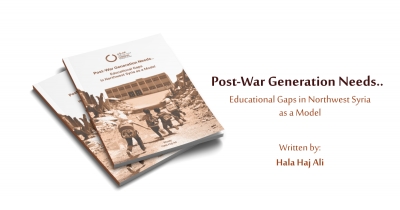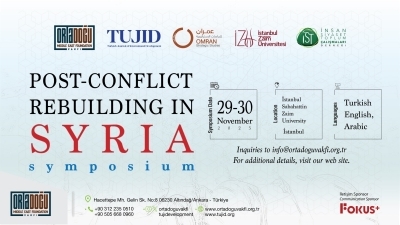Executive Summary
- Education, along with its continuity, serves as a cornerstone of "early recovery". It plays a decisive role in maintaining the intellectual and cognitive development of the post-war generation. The significance of education is underscored by its unique role in fostering a high level of psychological, social, and economic stability for both the individual and the wider community.
- Understanding the obstacles and gaps that impede the progress of the educational process in northwestern Syria is essential. It is crucial to determine the depth, causes, and factors contributing to these challenges. Gaining this understanding will provide a concrete foundation for future policies. For effective resolution, we must grasp both the visible and hidden dynamics of the educational process.
- This understanding becomes increasingly vital, especially in the face of declining educationquality and the deterioration of its quantitative and qualitative adequacy. This decline is evidenced by increasing dropout rates, school truancy , and student failures. For instance, 18% of school-age children are not enrolled in any form of education, and more than three-quarters of students between the ages of 12 and 17 have left school.
- The diversity of players in the education sector and their differing policies resulted in a lack of clear governance. Instead of a single central authority, numerous centers of differing competencies, executive plans, roles, and authorities emerged. This scenario has led to the existence of a variety of educational certificates, in addition to the absence of a structured decision-making mechanism within the education system; and lack of clarity in roles and responsibilities which amplifies ambiguity within the educational process. This lack of transparency has consequently eroded the trust of students, parents, teachers, and administrators.
- The funding provided to support higher levels of education is on the decline, while the aid given to elementary educational stages remains insufficient (The Humanitarian Response Plan for Syria has only received 25% of its required funding). Furthermore, the lack of a single coordinating body to regulate the work among different organizations led to a duplication of efforts, resulting in additional wasted resources and efforts. Often, there's a noticeable absence of coordination among these entities.
- The nature of the relationship between the financial backers and the organizations often resulted in a lack of attention to the involvement of local entities in evaluation and implementation processes. A noteworthy observation in this context is the extensive distribution of protection and psychological support programs. Those far outnumber the programs and activities specifically aimed at supporting education.
- Both areas are suffering from a shortage of qualified educators and a lack of scientific expertise among teachers. Moreover, there is a noticeable decline in the overall number of teachers living in the camps. This shortage is primarily attributed to the permanent relocation of teachers due to displacement; or their extended absence from the majority of school hours as a result of living conditions. Adding to the complexity, the prevailing security chaos instills fear among teachers towards military entities and influential figures. Additionally, there is a distinct shortage of female teachers in the studied area, further exacerbating the issue.
- The area of study is suffering from low academic performance among students, particularly in fundamental subjects. This situation necessitates the implementation of enrichment programs within the curriculum to bolster student understanding, broaden their perspectives, and facilitate their integration with the modern world. This can be achieved through the incorporation of technology in the education process.
- Furthermore, an emphasis on promoting shared living values in the curriculum is crucial. Despite peace among individuals being largely contingent on political and societal agreements, the lack of curriculum content, or activities addressing communal living and societal interaction could potentially undermine the principles of citizenship. This could be especially detrimental during periods of societal conflict and in their aftermath.
- Indicators associated with infrastructure gaps in schools include factors such as the lack of presence and insufficiency of educational facilities, their geographic distribution, capacity, safety within the school environment, availability of playgrounds and physical activity areas, as well as the availability of necessary healthcare services. When it comes to teachers, indicators include their numerical adequacy, gender balance, financial compensation, educational qualifications, expertise, and the level of security they experience. Curriculum and educational resource-related indicators cover aspects such as curriculum modifications and structural aspects; indicators of educational poverty; investment in education; religious influences on the curriculum; as well as the availability of textbooks and supplementary educational resources. Student-related indicators include the importance of access to education, school dropout rates, financial capabilities of students, privatization of education, the impact of war, psychological pressures, and social factors affecting students.
- The study proposes several recommendations the educational gaps. These include the importance of launching advocacy campaigns to accurately assess needs and advocating for humanitarian aid to be allowed through crossborder mechanisms rather than being restricted to crossline deliveries. It also emphasizes the need to strengthen local involvement in overseeing the educational process and enhance coordination between different stakeholders. The study suggests going beyond relying solely on organizational estimates by establishing an official mechanism for needs assessment. Additionally, it recommends bolstering Syrian funding channels for education and working towards a self-sustaining Syrian financing cycle. Lastly, it highlights the necessity of supporting the creation of a dedicated mechanism to assess school needs, ensure proper technical specifications, and promote equitable distribution.
To Read Full Study: https://2u.pw/ntiRzdT




